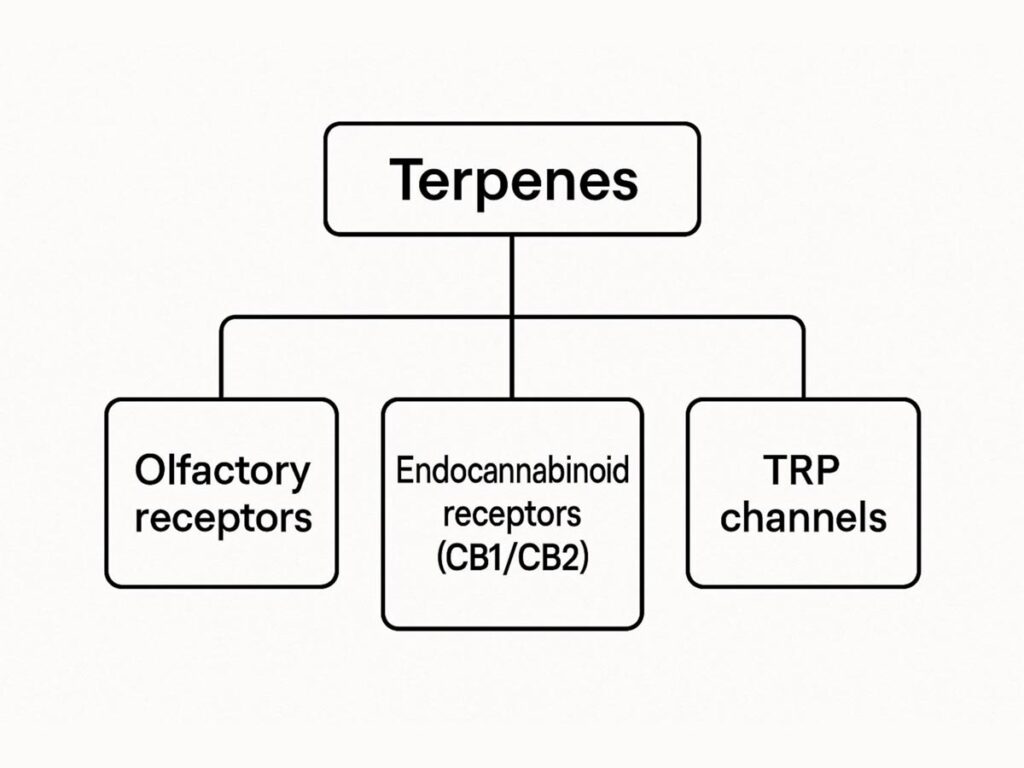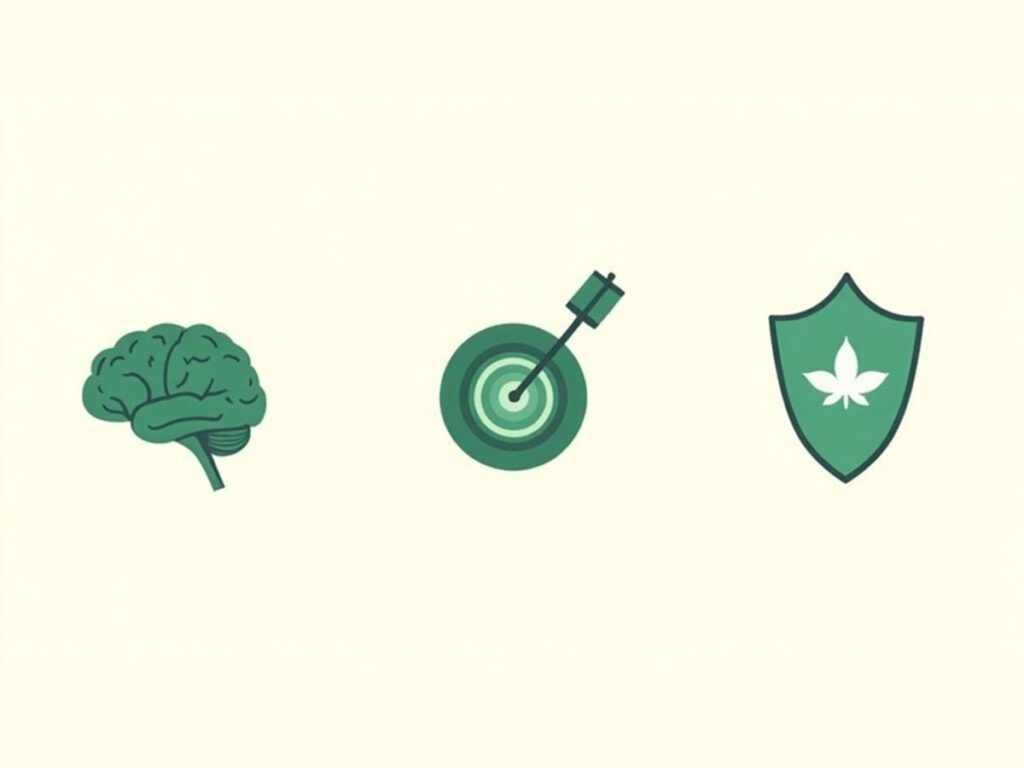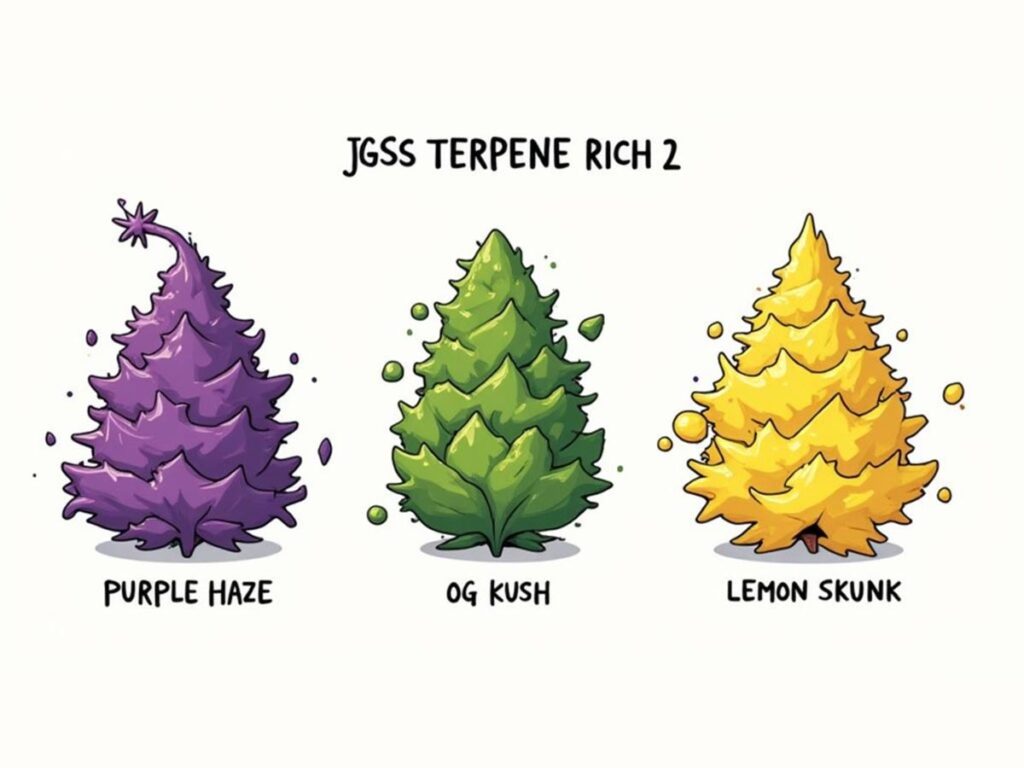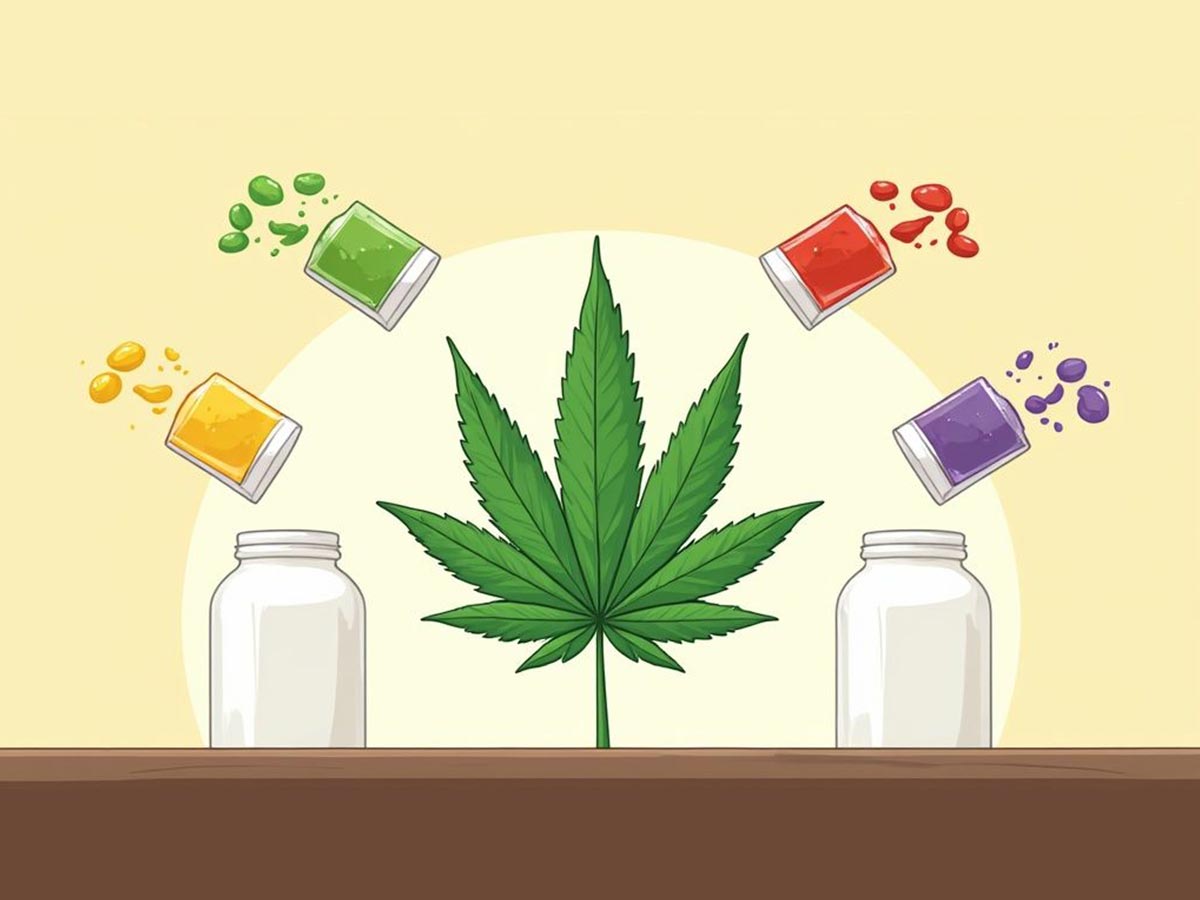Ever opened a jar of premium cannabis and been hit with a wave of zesty lemon, deep pine, or sweet berries? That’s the magic of terpenes. Often called “terps,” these aromatic compounds are the secret ingredient that makes one strain feel uplifting and energizing, while another lulls you into deep relaxation.
Understanding what terps are is the key to unlocking a better, more predictable cannabis experience. Let’s dive in.
What Are Terps and Why Do They Matter?
Think of cannabis like a symphony orchestra. Cannabinoids like THC and CBD are the star soloists, but terpenes are the entire string, woodwind, and percussion sections. They create the texture, mood, and depth of the entire performance. These aromatic oils are produced in the same tiny glands as cannabinoids, and they are responsible for the distinct flavors and aromas of your favorite strains—from OG Kush’s earthy punch to Tangie’s citrus explosion.
But terpenes aren’t exclusive to cannabis. They are nature’s essential oils. The calming scent of lavender? That’s the terpene linalool. The sharp, fresh smell of a pine forest? Pinene. The bright, mood-lifting aroma of a freshly peeled orange? That’s limonene. In nature, these compounds serve a practical purpose: protecting plants from predators and attracting beneficial pollinators.
Beyond Aroma: The Real Impact of Terpenes
The power of terpenes extends far beyond a pleasant scent. They are a massive class of organic compounds used in everything from cosmetics and perfumes to food and medicine. The global terpene market is already valued at over USD 1.2 billion and is projected to more than double by 2033, a testament to their growing importance.
For you, the cannabis user, this knowledge is a superpower. By understanding which terpene profiles you enjoy, you can move beyond choosing products based on THC percentage alone. Instead, you can pinpoint the strains that consistently deliver the exact effects, flavors, and aromas you want.
By learning to identify key terpenes, you empower yourself to find the perfect cannabis product for any mood or occasion, transforming your selection process from a guess into a science.
If you’re just starting your journey, this is one of the most valuable concepts to learn. For a solid foundation on the basics, explore our guide on cannabis for newbies. Grasping what terps are is the first step toward appreciating the incredible complexity that makes each cannabis strain a unique adventure.
How Terpenes Shape Your Cannabis Experience
For decades, the cannabis conversation was dominated by THC and CBD levels. While those numbers are important, they only tell a fraction of the story. Focusing on them alone misses the most exciting concept in modern cannabis science: the entourage effect. This is the theory that all the compounds in the cannabis plant work in synergy to produce an effect that’s greater than the sum of its parts.
Imagine a band again. THC might be the charismatic lead singer, but the terpenes are the skilled musicians behind them. The drummer sets the tempo, the guitarist delivers a powerful solo, and the bassist provides the soulful groove. A singer alone is just a voice; with the band, it becomes an unforgettable concert.
That’s precisely how terpenes interact with cannabinoids. They create a symphony of effects that fine-tunes your entire experience. This is why two strains with identical THC levels can feel completely different—one might be an energizing rock anthem, while the other is a soothing, mellow ballad.
The Entourage Effect Explained
At its heart, the entourage effect is all about teamwork. Terpenes and cannabinoids collaborate, interacting with each other and your body’s own endocannabinoid system to amplify and modify the effects.
For example, a study published in the scientific journal Molecules found that terpenes can enhance the activity of cannabinoids, showcasing this powerful synergy. They can influence how much THC crosses the blood-brain barrier and how it binds to your receptors.
This teamwork creates the distinct “vibe” of each strain:
- A strain rich in linalool (the same terpene in lavender) can enhance the calming, anxiety-reducing properties of cannabinoids.
- A profile dominant in limonene (the citrus terp) can contribute to a brighter, more euphoric, and uplifting mood.
- The presence of myrcene is often linked to the potent sedative or “couch-lock” effect that many associate with classic indica strains.
This complex interaction is also why the old “indica vs. sativa” labels are becoming obsolete. To understand why terpenes are a much more accurate guide, you can dive deeper into the differences between indica and sativa effects.
Why You Should Look Beyond THC Percentage
Chasing the highest THC percentage is like choosing a wine based only on its alcohol content—you miss all the nuance, flavor, and character that make it special. A smarter, more effective way to select your cannabis is by examining its terpene profile.
When you select a product based on its terpenes, you are choosing a specific experience, not just a level of intensity. This is the secret to finding a strain that consistently meets your needs.
So, the next time you visit a dispensary, ask to see the lab report, or Certificate of Analysis (COA). It will list the dominant terpenes in the product. By learning about what each one does and, most importantly, letting your nose guide you, you can stop guessing and start making informed choices. It’s the best way to ensure every session is exactly what you’re looking for.
Meet the Most Common Cannabis Terpenes
Now that you understand the “why,” let’s meet the major players. Think of these as the A-list celebrities of the terpene world. Familiarizing yourself with their signature aromas and potential effects is the first step toward becoming a connoisseur who can pick the perfect strain every time.
Each terpene has its own unique personality. Learning to identify them is like a chef learning their spices—it elevates the entire experience and helps you pinpoint exactly what you enjoy.
Myrcene: The Relaxing Powerhouse
If a cannabis strain smells earthy, musky, and slightly fruity like a ripe mango, you’re likely smelling Myrcene. As one of the most prevalent terpenes in modern cannabis, it’s famous for its deeply relaxing and sedating qualities.
This is the terpene often credited with that classic “couch-lock” feeling, making strains high in Myrcene a fantastic choice for unwinding after a long day or preparing for a restful night. Beyond cannabis, you’ll find myrcene in hops, thyme, and mangoes.
Limonene: The Bright Mood-Lifter
Just as its name implies, Limonene offers a vibrant, zesty burst of fresh citrus. Think of the uplifting aroma you get from peeling a lemon or an orange. This terpene is associated with elevated moods and stress relief, making it a popular choice for daytime use or social situations.
Limonene’s influence is widespread. In fact, orange terpenes are a cornerstone of the natural ingredients market, used in everything from household cleaners to food flavorings for their pleasant, effective, and non-toxic properties.
The image below illustrates how terpenes like limonene interact with our biological systems.

As you can see, these compounds do more than just smell good—they engage with key pathways like our endocannabinoid system to shape the entire cannabis experience.
Linalool: The Calming Floral Note
Ever wonder why lavender is a key ingredient in aromatherapy for relaxation? You can thank Linalool. This terpene has a delicate, sweet, and floral aroma and is widely celebrated for its gentle, soothing properties that can help ease anxious feelings and promote rest.
If you encounter a cannabis strain with distinct lavender notes, it’s a strong sign that Linalool is present. It’s a perfect choice for moments when you need to de-stress and find a sense of peace without heavy sedation.
Caryophyllene: The Spicy Soother
With its spicy, peppery aroma reminiscent of black pepper or cloves, Caryophyllene (or Beta-caryophyllene) is unique. What makes this terpene so special is its ability to act like a cannabinoid by binding directly to the CB2 receptors in our endocannabinoid system.
This direct interaction gives it significant potential for soothing discomfort and reducing inflammation, a finding supported by the National Library of Medicine. So, if your bud has a spicy or woody scent, caryophyllene is likely a key player.
Pinene: The Forest-Fresh Focus Booster
Finally, Pinene smells exactly like its namesake: a crisp, refreshing pine forest. It’s one of the most common terpenes in the natural world and comes in two types: alpha-pinene (pine needles, rosemary) and beta-pinene (dill, parsley).
Pinene is often associated with alertness, focus, and memory retention. Some users find it helps counteract the potential fogginess from THC, making it a great option when you want to stay sharp and engaged.
To make it even easier to remember these key players, here’s a quick-reference table.
Common Cannabis Terpenes At a Glance
| Terpene | Common Aroma | Potential Effects | Also Found In |
|---|---|---|---|
| Myrcene | Earthy, Musky, Fruity | Relaxing, Sedating | Mangoes, Thyme, Lemongrass |
| Limonene | Citrus, Lemon, Orange | Uplifting, Stress Relief | Citrus Rinds, Juniper, Peppermint |
| Linalool | Floral, Sweet, Lavender | Calming, Soothing | Lavender, Coriander, Birch Bark |
| Caryophyllene | Spicy, Peppery, Woody | Soothing, Anti-inflammatory | Black Pepper, Cloves, Cinnamon |
| Pinene | Pine, Fresh, Herbal | Alertness, Focus, Memory | Pine Needles, Rosemary, Basil |
Keep this guide handy, and you’ll be well on your way to navigating the dispensary like a pro, choosing strains based not just on THC content, but on the rich aromatic experience you’re looking for.
How to Find Your Perfect Terpene Profile

You’ve learned the theory, now it’s time for the fun part: putting that knowledge into practice to find the cannabis that’s perfect for you. This is where you become a “terpene hunter,” moving beyond guesswork to consistently pick products that deliver your desired experience. It all comes down to two simple things: trusting your senses and reading the label.
Your most powerful tool is your nose. Terpenes are all about aroma, so if a strain has a scent that you find irresistible, that’s your first and best clue.
Does it smell bright and citrusy, making you feel instantly uplifted? Or is it a deep, earthy scent that feels grounding and calm?
Your nose knows. The scents you are naturally drawn to often indicate a terpene profile that will harmonize with your body’s unique chemistry.
Let your senses guide you first. It’s an intuitive, powerful way to connect with the plant’s chemistry that numbers on a chart can never replicate.
How to Read a Certificate of Analysis
While your nose is the best starting point, a Certificate of Analysis (COA) is your source for hard data. Any reputable dispensary will provide these lab reports for their products. At first glance, a COA can seem complex, but you only need to focus on one key section.
Look for a chart listing the terpenes and their concentrations, usually shown as a percentage (%) or in milligrams per gram (mg/g).
Here’s what to look for:
- Dominant Terpenes: The report will list the top three to five terpenes in that batch. These are the primary drivers of the product’s aroma, flavor, and effects.
- Concentration Levels: Pay attention to which terpenes are most abundant. A strain might contain both limonene and myrcene, but the one with the higher percentage will have a greater influence on the experience.
- Total Terpene Percentage: This number gives you an idea of how aromatic and flavorful the product will be. A total terpene content over 2% is generally considered robust and high-quality.
Once you start comparing the COA with how a product smells and makes you feel, you’ll discover your personal patterns. You might realize that your favorite energizing strains are all high in limonene and pinene. If you need inspiration, our guide to the best cannabis strains for any mood is a great resource for connecting effects with specific strains.
Preserve Your Terps with the Right Consumption Method
Finally, how you consume your cannabis makes a huge difference. Terpenes are volatile compounds, meaning they evaporate easily at high temperatures. This is a crucial detail that many people overlook.
When you smoke cannabis using a lighter, the intense heat instantly destroys many of the most delicate terpenes. While you’ll still get some flavor, you’re missing out on the full, nuanced profile you paid for.
To truly savor the complex flavor and maximize the entourage effect, consider vaporization. Vaporizers heat cannabis at much lower, controlled temperatures (typically 320-380°F or 160-193°C), releasing the terpenes as a flavorful vapor without incinerating them. This method delivers a cleaner, more aromatic experience and gives you far more control.
The Future of Terpenes in Wellness and Industry
What you’ve learned about terpenes isn’t just for choosing better cannabis. These aromatic powerhouses are making waves far beyond the dispensary, becoming star ingredients in everything from advanced skincare to gourmet food and beverages.
By understanding terps now, you’re getting a front-row seat to one of the most exciting innovations in the natural products industry.
Consumers are increasingly demanding natural, plant-based solutions. Terpenes provide potent aromas, unique flavors, and beneficial properties without synthetic additives, fueling their expansion into new and exciting markets.
From Aromatherapy to Everyday Products
The incredible versatility of terpenes means you are likely already using them every day.
- Aromatherapy and Wellness: The linalool in your calming essential oil diffuser and the limonene in an uplifting body lotion are terpenes hard at work.
- Food and Beverage: Craft brewers have long manipulated hop-derived terpenes to create signature IPA flavors. Food scientists also use them to create all-natural flavorings.
- Natural Cleaning Products: The powerful grease-cutting and fresh-scenting properties of many eco-friendly cleaners come from terpenes like pinene and limonene.
This broad appeal is why the global terpene market is booming. Valued at USD 1.25 billion, it’s projected to nearly double to USD 2.36 billion by 2031, with huge demand coming from the cosmetics, food, and cannabis sectors. You can explore the data behind this trend at Verified Market Research.
The Next Frontier in Medicine
Perhaps the most promising future for terpenes lies in medicine. Researchers are actively working to isolate specific terpenes and harness their targeted health benefits.
Early studies are exploring their potential as powerful anti-inflammatory, anti-anxiety, and antimicrobial agents. This research could pave the way for a new generation of effective, plant-derived medicines.
As science continues to unlock their secrets, terpenes may soon be as valued for their therapeutic potential as they are for their captivating aromas.
Learning about terps isn’t just a niche cannabis skill—it’s about understanding powerful natural compounds that are actively shaping the future of health, wellness, and the consumer products we use every day.
The same knowledge that helps you pick a fantastic new strain at the dispensary can also help you choose a more effective essential oil or better appreciate the complex flavors in your favorite craft beer.
Still Have Questions About Terpenes? Let’s Clear Things Up.

You now have a solid understanding of what terps are and how they can revolutionize your cannabis experience. But it’s natural to have a few more questions. We’ve answered some of the most common ones to ensure you feel completely confident on your terpene journey.
Do Terpenes Get You High?
No, terpenes are not psychoactive on their own. They will not produce the “high” associated with THC. However, they absolutely influence that high.
Think of it this way: THC determines the altitude of your flight, but terpenes are the pilots who steer the plane. Myrcene might guide you toward a smooth, sleepy landing, while limonene could steer you into a bright, sunny sky. Terpenes don’t create the high, but they absolutely shape its character and direction.
Are Terpenes Legal and Safe?
Terpenes are everywhere in nature, found in countless plants we use and consume daily. In the United States, the Food and Drug Administration (FDA) classifies most common terpenes as generally recognized as safe (GRAS) for use in food and cosmetics. The pinene in your cannabis is chemically identical to the pinene in a pine needle.
Legality, however, depends entirely on the source. If terpenes are derived from hemp or other non-cannabis plants, they are typically legal. When they are part of a cannabis product containing THC above the legal limit, their legal status is tied to local cannabis regulations.
The same natural compounds that give lavender its calming aroma and lemons their zesty kick are found in cannabis. Their safety is well-established, but their legality always depends on the plant they came from.
Can You Be Allergic to Terpenes?
Yes, although it’s uncommon, it is possible. Just as people can have sensitivities to pollen or certain foods, some individuals may react to specific terpenes.
For example, if you know that strong floral scents sometimes trigger a headache, you might be sensitive to strains high in linalool. Reactions are typically mild and may include skin irritation, a runny nose, or a headache. When trying a new product with a very strong aroma, it’s always wise to start with a small amount and see how your body responds.
How Are Terpenes Different From Cannabinoids?
This is the most crucial distinction to understand. Cannabinoids and terpenes are two entirely different classes of chemical compounds that work together.
Here’s the simple breakdown:
- Cannabinoids (e.g., THC, CBD): These are the primary active ingredients. They interact directly with your body’s endocannabinoid system to produce the main effects of cannabis, including the psychoactive high and significant therapeutic benefits.
- Terpenes (e.g., Myrcene, Limonene): These are the “influencers.” They provide the aroma and flavor while working synergistically with cannabinoids to modify and refine the overall effects. This teamwork is the entourage effect.
Think of it like building a house: cannabinoids are the foundation and the walls, but terpenes are the interior designers who choose the paint colors, furniture, and lighting to create a specific mood and atmosphere. You need both to create a complete and unique experience.
Ready to put your new knowledge to the test? At Wallflower Cannabis House, our budtenders are passionate terpene experts dedicated to helping you find your perfect match. Visit one of our Las Vegas locations or browse our menu online to discover our incredible selection of terpene-rich products today.

